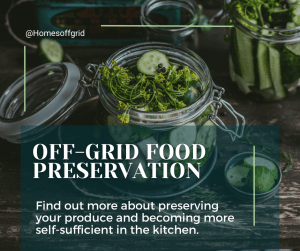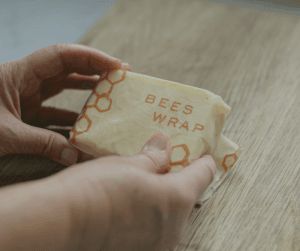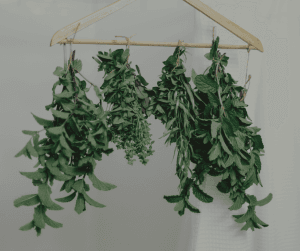For those embracing the self-sufficient lifestyle, off-grid food preservation is a vital skill that ensures a constant and varied food supply, even in the absence of conventional food providers. Learning how to sustainably preserve produce will increase your self-sufficiency hugely. It isn’t only about extending the shelf life of perishables; with limited access to food shops and constant refrigeration, preserving food becomes a means of bridging the gap between abundance and scarcity. Preserving harvested or even purchased food allows you to embrace the cycles of nature, capturing the essence of each season’s bounty, and ensuring a consistent source of healthy ingredients.
In this article, you’ll discover sustainable food preservation techniques tailored to off-grid living. These methods not only help you stock up on essentials but also allow you to reduce waste, save money, and maintain a more self-sufficient lifestyle. From traditional techniques like canning and smoking to modern off-grid refrigeration options, you’ll gain a comprehensive understanding of how to build a resilient food supply that supports your off-grid journey.

Off-Grid Food Preservation Methods
When living off-grid, mastering food preservation is essential for ensuring that your food supply remains diverse, nutritious, and available year-round. Each technique has its own advantages, suited to different types of food and available resources. Here is an overview of the most effective food preservation methods that are suitable for off-grid living.
Canning
Canning is a traditional method that allows you to store fruits, vegetables, and even meats for long periods without refrigeration. It works by sealing food in airtight containers, preventing the growth of bacteria.
Water Bath Canning: Water bath canning, dating back to the 18th century, is ideal for high-acid foods. With pH levels below 4.6 foods such as fruits, pickles, and tomatoes rely on high acidity to prevent bacterial growth. The process involves filling sterilised jars with your food, securing the lid and submerging the filled jars in a pot of boiling water for a specific period, allowing the contents to reach the necessary temperature for preservation. This kills bacteria and seals the jars keeping your preserves safe from spoilage. The water bath canning method is simple and effective, making it a must for off-grid preservation.
Pressure Canning: The evolution of canning continued with the introduction of pressure canning in the 19th century. This method became a safeguard for low-acid foods, preserving vegetables, meats, and stews. By using pressure to reach higher temperatures than boiling water can achieve, this method ensures the elimination of harmful bacteria like Clostridium botulinum. Pressure-canned foods become staples in your pantry, offering constant nutrition and convenience during off-grid living. Fill jars with prepared food then seal and place them in a pressure canner with water. Process at the required pressure and time, ensuring safe preservation. Though it requires more equipment, pressure canning is crucial for safely preserving a wider variety of foods.
Fermentation
Fermentation is an ancient preservation method that not only extends the shelf life of food but also enhances its nutritional value by creating beneficial probiotics.
Lacto-fermentation: Lacto-fermentation is an anaerobic process where natural bacteria feed on the sugars in food, producing lactic acid and creating an environment inhospitable to harmful bacteria. This practice is as old as civilization itself, tracing its roots to ancient cultures seeking innovative ways to preserve food. One classic example of this method is sauerkraut which originated in Central Europe over 2,000 years ago and is renowned for its probiotic benefits. The lactic acid produced by the bacteria creates a tangy flavour which is a great addition to your off-grid meals. Submerge vegetables in a brine solution and allow natural bacteria to ferment the sugars in the vegetables. This form of pickling doesn’t require any special equipment and is a great way to preserve the harvest while boosting gut health.
Chemical pickling: Pickling, a practice ingrained in various cultures globally, has a history dating back to ancient Mesopotamia. The method ensured sustenance during lean times. Pickling involves immersing foods in an acidic brine or vinegar solution, which inhibits bacterial growth. From cucumber spears to herring fillets, pickling lets you preserve a wider range of food for months to come and adds a stronger flavour to your meals.
It’s worth noting that the products of pickling and fermentation often overlap but aren’t always synonymous. Some pickled foods undergo a fermentation process, while certain fermented foods might not involve pickling. The methods can be combined for a double layer of preservation.
Dehydration
Dehydration removes moisture from food, which inhibits the growth of bacteria and mould. This method is energy-efficient and highly effective for a variety of foods.
Solar Dehydration: Solar dehydration is a natural, energy-efficient method for removing moisture from foods harnessing the sun’s energy to dry food naturally. This method is particularly suitable for fruits, vegetables, and herbs. Slicing fruits or vegetables thinly and evenly ensures consistent drying. Place them on trays within a solar dehydrator, allowing the sun’s heat to slowly extract moisture over several hours or days. Rotate the trays periodically for uniform dehydration. The appliance’s design should maximise exposure to sunlight while protecting the food from pests. Using a solar dehydrator, you can preserve large quantities of food without relying on electricity, making it a perfect off-grid option.
Freeze-Drying: Although freeze-drying typically requires specialised equipment, it’s an excellent method for preserving food. Freeze-drying involves freezing food at extremely low temperatures, then subjecting it to a vacuum to remove ice crystals via sublimation. While it’s a lengthier process, it preserves the texture, flavour, and nutritional value exceptionally well. Pre-freeze the food, then transfer it to the freeze-drying machine. This creates the vacuum environment, lowering the atmospheric pressure, causing frozen water in the food to transition directly from a solid to a gaseous state. If you have access to a freeze-dryer, it’s worth considering for its long-term preservation capabilities.
Air Drying: Air drying is one of the simplest and oldest methods of dehydration. This is a straightforward method suitable for herbs, fruits, flowers, and some vegetables. Ensure your produce has proper ventilation in a dry, warm area away from direct sunlight where it can dry naturally over time. Hang food items in bundles or on drying racks, allowing air circulation to gradually remove moisture. Monitor regularly to prevent mould growth or spoilage. This method is especially effective for herbs and leafy greens.
Dehydrator: Using a dehydrator allows you to control the drying process with consistent temperatures. This streamlines the dehydration process and makes it suitable for a wide range of foods. Prepare the food by slicing it evenly and arranging it on the dehydrator trays. Set the temperature based on the type of food, ensuring it reaches the desired level of dryness. Although it requires electricity, you can power a dehydrator with solar panels or other off-grid energy sources.
Each dehydration method offers unique advantages, catering to different types of food and varying circumstances, ensuring a diverse and plentiful off-grid pantry.

Smoking
Smoking is another ancient preservation technique that adds a distinctive flavour to foods while preserving them. It’s particularly effective for meats and fish. Utilising the smoke from burning wood chips or sawdust, this technique dries and adds a smoky flavour to foods. The process involves curing the meat with salt to remove excess moisture, followed by cold smoking at a controlled temperature. By exposing food to smoke from burning wood, you can create an environment that slows bacterial growth and dries the food, extending its shelf life. Different woods provide distinct flavours but monitoring temperature and proper ventilation are crucial for safe preservation and optimal taste. Smoking can be done in a homemade smoker, making it accessible for off-grid living
Root Cellars
Root cellars provide a natural, energy-free way to store root vegetables, fruits, and other perishables. By making use of the earth’s natural insulating properties, root cellars maintain a cool, stable temperature and high humidity, ideal for preserving crops like potatoes, carrots, and apples. Root cellars are typically built underground or into a hillside and should be constructed with proper insulation, adequate ventilation, and shelving for organised storage. The consistent temperature slows spoilage and extends the shelf life of produce. Building a root cellar is a practical investment for long-term off-grid food storage.
Off-Grid Refrigeration Options
Refrigeration can be challenging when living off-grid, but there are alternative methods to keep food cool without conventional electricity. Options include propane-powered refrigerators, which use gas to cool food, or highly efficient solar-powered fridges that can run off your solar energy system. Zeer pots are a more traditional solution, consisting of two clay pots – one placed inside the other – with the space between filled with sand or a damp cloth. As the moisture evaporates, it cools the inner pot, acting as a refrigerator. Other inventive methods include using cool streams or natural springs and storing perishables in the shaded, flowing water source. These solutions allow you to maintain perishable goods even in an off-grid setting.
By incorporating these food preservation methods into your off-grid lifestyle, you can ensure a reliable and sustainable food supply throughout the year, no matter the season.
Sustainable Packaging for Preserved Foods
Once you’ve mastered various food preservation methods, the next important step is ensuring that your preserved foods are stored in a way that maintains their quality while minimising environmental impact. Sustainable and reusable or DIY packaging is crucial for reducing waste and ensuring your off-grid lifestyle aligns with your values of self-sufficiency and environmental stewardship. Here are some sustainable options:
Fabric and Beeswax Wraps: Crafting fabric and beeswax wraps offer an eco-friendly alternative to plastic cling film. Cut cotton fabric into squares or circles, place it on a baking sheet, and sprinkle grated beeswax evenly. Bake until the wax melts, coating the fabric. These wraps become pliable once cooled, forming a seal around food items. They are perfect for wrapping fruits, vegetables, cheese, or covering bowls. They’re breathable, naturally antibacterial, and can be reused for several months before needing to be refreshed or composted.
Cloth, Knit, or Crochet Bags: Cotton and linen bags are excellent for storing bulk items like grains, legumes, and dried herbs. Repurpose old fabrics, knit, or crochet to create your own sustainable packaging for dry goods. These natural fibers allow for some air circulation helping to maintain food freshness. These bags can be easily washed and reused, making them a sustainable choice for food storage.
Glass Jars: Glass jars are a staple in food preservation, particularly for canning. They’re durable, non-reactive, and infinitely reusable, making them an ideal choice for long-term storage. Glass doesn’t leach chemicals into your food and provides a tight seal to keep out air and moisture. After consuming the contents, the jars can be cleaned and reused multiple times, reducing the need for single-use packaging. Upcycling shop-bought glass jars, like those from pasta sauces or pickles, offers an environmentally friendly solution that may be preferable to purchasing new jars. Label the jars for easy identification and an organised pantry.
Silicon Storage Containers: Investing in reusable silicon storage containers reduces the need for single-use plastic. They come in various shapes and sizes, perfect for storing a range of preserved foods, including soups, fermented goods, and leftovers. These containers are durable, freezer-safe, and easy to clean, offering long-term and versatile storage solutions.
Compostable Bags: For those occasions when you need something a bit different, compostable bags offer a practical alternative. These bags are made from plant-based materials and break down naturally over time. They’re suitable for storing dried goods like herbs, fruits, and vegetables, providing a biodegradable option.
By integrating these sustainable packaging materials and DIY solutions into your off-grid food preservation practices, you contribute to a more sustainable lifestyle. These practices reduce waste and also ensure that your preserved foods remain fresh and safe for consumption over time.

Integrating Permaculture Practices
Permaculture is an essential philosophy for off-grid living, focused on creating sustainable, self-sufficient ecosystems. When it comes to food preservation, integrating permaculture principles not only helps you grow more resilient crops but also ensures that your preservation efforts are sustainable and efficient. By growing and preserving perennials and using companion planting, you can enhance your off-grid food supply and reduce your dependency on external resources.
Growing and Preserving Perennials
Perennial plants are a cornerstone of permaculture gardening, offering long-term food sources with less labour and input compared to annuals. These plants come back each year, making them ideal for an off-grid lifestyle where sustainability and resource management are paramount.
Perennial Vegetables and Herbs: Perennial vegetables like asparagus, rhubarb, and artichokes, along with herbs such as rosemary, thyme, and sage, are excellent choices for an off-grid garden. These plants require less maintenance once established and can provide a reliable food source for years. Because they are less dependent on seasonal planting cycles, perennials offer a consistent supply of food that can be preserved through various methods like drying, fermenting, or freezing, ensuring you have access to nutritious foods year-round. By focusing on perennials, you create a self-sustaining food system, reducing the need for replanting and intensive labour each season.
Fruit and Nut Trees: Fruit and nut trees are another valuable addition to a permaculture-based food system. Trees like apple, pear, peach, walnut, and hazelnut can provide a bounty of food that can be preserved. Properly managed, these trees not only yield food but also contribute to the overall health of your ecosystem by improving soil structure, providing shade, and offering habitats for beneficial wildlife. Fruits can be dried, canned, or made into jams. Herbs can be dried or frozen, maintaining their flavour and nutritional value. Nut harvests can be stored in cool, dry conditions or roasted and stored in airtight containers.
Companion Planting for Preservation
Companion planting is a permaculture practice that involves growing certain plants together to benefit each other. This method not only improves the health and yield of your garden but also plays a role in preserving the produce by naturally extending the growing season and deterring pests.
Pest Control and Pollination: Companion planting can help protect your crops from pests, reducing the need for chemical interventions. For example, planting marigolds alongside tomatoes can deter nematodes, while basil repels whiteflies and aphids. Similarly, garlic planted near fruit trees can deter pests and protect the trees from diseases. Meanwhile, plants like lavender and borage attract pollinators, ensuring a better harvest that can be preserved through various methods. By naturally managing pests and encouraging pollination, you reduce crop losses and increase the amount of food available for preservation.
Extended Harvests: Certain plant pairings can help extend the growing season, allowing you to stagger your harvests for continuous preservation. For example, planting radishes with carrots can help break up soil, allowing the carrots to grow more efficiently. This results in a longer harvest period where you can continually process and preserve the produce, ensuring a steady supply of food rather than a single overwhelming harvest.
Soil Health and Nutrient Cycling: Companion planting also enhances soil health, which is crucial for the long-term success of your off-grid food production. Plants like legumes fix nitrogen in the soil, benefiting nearby crops that are heavy feeders, like corn. Healthy, nutrient-rich soil leads to more robust plants and higher yields, providing more food to preserve and store. Additionally, healthier soil reduces the need for external fertilisers, further aligning with sustainable living practices.
By integrating permaculture practices such as growing and preserving perennials and companion planting into your off-grid lifestyle, you create a more resilient and sustainable food system. These methods not only enhance your food production but also ensure that your preservation efforts are efficient and aligned with the principles of permaculture. If you would like to learn more about self-sufficient gardening click here.
Building a Year-Round Off-Grid Pantry
Building a year-round off-grid pantry requires strategic planning and thoughtful execution. The goal is to ensure that your food supply remains abundant, diverse, and nutritious throughout the year, regardless of the season or environmental conditions. By following a seasonal food preservation calendar and creating a resilient food stock, you can maintain a steady supply of essential ingredients that support your self-sufficient lifestyle.

Seasonal Food Preservation Calendar
A seasonal food preservation calendar is an essential tool for managing your off-grid pantry. It helps you plan and organise your preservation activities based on the natural harvesting cycles of your crops. This ensures that you’re making the most of your harvests and preserving foods at their peak freshness and nutritional value.
Spring: Spring is a time of renewal and the beginning of many harvests. Early crops like asparagus, peas, spinach, and strawberries are ready for picking. This is the ideal time to begin canning and freezing these early harvests. Herbs such as chives, mint, and dill can be dried or frozen for later use. Planning for successive sowing of certain crops, like lettuce and radishes, allows for extended harvesting periods and continuous preservation opportunities.
Summer: Summer is the peak season for a wide variety of fruits and vegetables. Berries, tomatoes, cucumbers, courgette, and beans are abundant during this time. It’s crucial to take advantage of this abundance by preserving through canning, dehydrating, and fermenting. Making jams, pickles, and sauces can turn your summer harvest into preserved goods that will last throughout the year. Also, focus on drying herbs like basil, oregano, and thyme during this season.
Autumn: As the weather cools, root vegetables like carrots, beets, potatoes, and parsnips become ready for harvest, along with late-season fruits like apples and pears. Autumn is an excellent time to use root cellars for storing these hardier crops. Canning soups, stews, and apple sauces are also common practices during this period. This season is ideal for smoking meats and preserving nuts as well, ensuring a protein-rich pantry for the winter months ahead.
Winter: Winter is the season for consuming what you’ve preserved and stored throughout the year. However, certain activities, such as fermenting and curing meats, can continue. Utilise your root cellar and off-grid refrigeration solutions to maintain the quality of your stored foods. Planning your next year’s garden and assessing your pantry’s needs for the coming year is also a crucial task during this time.
By adhering to a seasonal food preservation calendar, you can maximise your harvests, reduce waste, and ensure that your pantry remains well-stocked throughout the year.
Creating a Diverse and Resilient Food Stock
A diverse and resilient food stock is the backbone of a successful off-grid pantry. It ensures that you have a wide range of foods available to meet your nutritional needs, regardless of external factors like crop failures or unexpected weather events.
Diversity in Preservation Methods: Utilising a variety of preservation methods – such as canning, drying, fermenting, and freezing – ensures that you’re not overly reliant on a single technique. This diversity increases the likelihood that your food will remain edible and nutritious, even if one preservation method fails. For example, if your canned goods are compromised due to a seal failure, your dried foods are still good.
Variety in Food Types: Stocking a wide variety of foods ensures a balanced diet. Include a mix of fruits, vegetables, grains, proteins, and fats in your pantry. Diversify within each category as well – for instance, store different types of beans, grains like rice and quinoa, and various preserved meats and nuts. This variety not only supports your nutritional needs but also keeps your meals interesting and enjoyable throughout the year.
Rotation and Inventory Management: Regularly rotating your food stock ensures that nothing goes to waste and that you’re always consuming the freshest preserved items. Implementing a “first in, first out” system helps you keep track of what needs to be used next. Periodically inventorying your pantry allows you to identify any gaps in your stock and plan accordingly to address those needs during the next harvest season.
Contingency Planning: Building resilience into your pantry also involves planning for potential disruptions. Stockpile non-perishable items like grains, legumes, and dried fruits, which have a long shelf life. Additionally, consider preserving seeds for replanting, ensuring you can continue to produce food even if your initial stock runs low. Having a plan for sourcing or preserving water is equally important, as it’s crucial for both food preparation and hydration.
By carefully planning your seasonal preservation activities and maintaining a diverse and resilient food stock, you can create a year-round off-grid pantry that supports your self-sufficient lifestyle. These strategies ensure that you have access to a wide range of nutritious foods throughout the year, regardless of external circumstances.
Challenges and Solutions with Off-Grid Food Preservation
Living off-grid and preserving your own food comes with unique challenges that require careful planning and adaptability. To ensure that your preserved foods remain safe, nutritious, and enjoyable, it’s essential to anticipate and address common issues that can arise. Explore the most typical challenges faced in off-grid food preservation and discover practical solutions for maintaining food quality and safety.

Addressing Common Issues in Off-Grid Food Preservation
Temperature Fluctuations: Maintaining consistent storage temperatures is crucial for the longevity of preserved foods. Off-grid living often means relying on natural methods like root cellars, or alternative energy sources like solar power, which can lead to temperature fluctuations. Insulate your storage areas well and consider using thermal mass, such as water barrels or stone, to stabilise temperatures. Root cellars should be well-ventilated to avoid moisture buildup, which can lead to mould and spoilage. Monitoring temperatures regularly can help you adjust conditions as needed.
Humidity Control: High humidity can cause mould growth, while low humidity can lead to dried-out food, especially for items like grains and root vegetables stored in cellars. Use natural desiccants like silica gel packs, rice, or charcoal to absorb excess moisture in storage areas. For low humidity, consider adding moisture through controlled methods like placing damp cloths near storage areas. Proper ventilation is also key in managing humidity levels.
Pest Infestation: Rodents, insects, and other pests can quickly ruin a pantry if not properly managed. Off-grid homes, especially those in rural or forested areas, are particularly vulnerable to pest intrusion. Store food in pest-proof containers such as glass jars, metal bins, or thick plastic tubs. Regularly inspect your food storage areas for signs of pests, and seal any cracks or gaps where they might enter. Natural repellents, such as bay leaves, peppermint oil, and diatomaceous earth, can also help deter pests.
Limited Access to Preservation Equipment: Off-grid living often means limited access to electricity, making it difficult to use conventional preservation equipment like freezers or electric dehydrators. Focus on preservation methods that don’t rely on electricity, such as solar drying, fermenting, and canning. Invest in manual tools like hand-cranked grain mills, non-electric food processors, and solar-powered appliances. For freezing, consider using a highly insulated chest freezer powered by solar panels or relying on natural ice storage in colder climates.
Nutrient Loss: Some preservation methods can lead to the loss of vital nutrients, particularly vitamins, over time. This is especially true with methods that involve heat, like canning and drying. To retain nutrients, use lower temperatures when drying foods and minimise cooking times during canning. Incorporate fermentation into your preservation routine, as it preserves and also enhances the nutritional value of certain foods. Rotate your food stock regularly to consume preserved items while they are still nutritionally robust.
Solutions for Maintaining Food Quality and Safety
Proper Sealing Techniques: Inadequate sealing of preserved foods can lead to contamination, spoilage, and foodborne illnesses. This is particularly a risk with canning and vacuum-sealed foods. Always follow proper canning procedures, including using the correct pressure for your altitude and ensuring jars are sealed tightly. Test seals after cooling by pressing the centre of the lid; it should not flex up or down. For vacuum sealing, check for a complete seal before storage and re-seal if necessary.
Regular Inspection of Preserved Foods: Even well-preserved foods can occasionally spoil. It’s crucial to catch this early to prevent the spread of contamination or loss of your food supply. Regularly inspect your preserved foods for signs of spoilage, such as discolouration, odours, or bulging lids. For dried foods, check for mould or unusual textures. If in doubt, it’s safer to discard potentially compromised items than to risk foodborne illness.
Adapting to Seasonal Variability: Off-grid living often exposes you to seasonal variability, potentially impacting food preservation and storage conditions. Adapt your preservation methods to the season. In summer, focus on canning and drying; in autumn, on root cellaring and fermenting; and in winter, on managing your stored food. Be prepared to adjust storage methods as temperatures rise or fall, and consider supplementary techniques like insulating root cellars in winter or using solar dehydrators in summer.
Ensuring Water Quality: Water is essential in food preservation, particularly in canning and fermenting. Off-grid water sources, however, may not always meet the quality standards necessary for these processes. Always use clean, potable water for preservation. If your water source is questionable, invest in a reliable filtration system or boil water before use. For fermenting, ensure that the water is free of chlorine, as it can interfere with the fermentation process. Rainwater can be an excellent source if collected and filtered properly.
Education and Continuous Learning: The field of food preservation is vast and ever-evolving, and off-grid conditions add layers of complexity. A lack of up-to-date knowledge can lead to mistakes that compromise food safety. Continuously educate yourself on best practices in food preservation. Utilise books, workshops, and online resources tailored to off-grid living. Networking with other off-grid families or homesteaders can provide valuable insights and shared experiences that improve your own practices.
By anticipating these challenges and implementing the solutions provided, you can significantly enhance the quality, safety, and longevity of your preserved foods. These proactive steps will ensure that your off-grid pantry remains a reliable and nutritious resource, supporting your sustainable lifestyle year-round.
Community and Off-Grid Food Sharing
Living off-grid is often associated with self-reliance, but it doesn’t have to mean isolation. One of the most enriching aspects of off-grid living is the opportunity to build and participate in a supportive community. Sharing resources, knowledge, and efforts not only lightens the workload but also strengthens the resilience of the community. Collective initiatives and bartering systems can be crucial in ensuring everyone has access to a diverse and stable food supply.

Collective Food Preservation Initiatives
Shared Resources and Equipment: Not everyone in an off-grid community may have access to the same preservation equipment or resources. By pooling these resources, community members can make the most of what’s available. Establish a shared equipment program where items like canners, dehydrators, and large storage containers are collectively owned and maintained. This system allows individuals who might not otherwise afford certain equipment to participate in preservation activities. Regularly scheduled preservation days can be organised where members bring their harvests and work together to preserve food. This way you create a sense of community and ensure that everyone benefits from the collective effort.
Group Preservation Workshops: Knowledge is one of the most valuable resources in off-grid living. Collective workshops on food preservation methods can empower the entire community with skills that enhance their self-sufficiency. Organise workshops where experienced members teach others about various preservation techniques such as canning, fermenting, drying, and smoking. Practical workshops would allow participants to practice the methods and leave with preserved food to add to their pantries. Workshops also offer a platform for exchanging tips and adapting traditional preservation methods to suit off-grid conditions.
Community Food Banks: A community food bank for preserved goods can act as a safety net for those in need, especially during hard times or unexpected shortages. Set up a system where community members can contribute a portion of their preserved foods to a communal storage. This food bank can be managed by a designated group and accessed by members in times of need. The food bank could also operate on a rotating basis, where members can trade in their contributions for different types of preserved foods, ensuring variety in their pantries.
Cooperative Gardening and Harvesting: Cooperative efforts in gardening and harvesting can yield larger and more diverse crops, providing more raw materials for preservation. Form cooperative gardening groups where members share the work of planting, tending, and harvesting crops. The collective harvest can then be divided among participants, with some set aside for community preservation initiatives. This increases the quantity and food variety available for preservation and strengthens the community by fostering collaboration and shared responsibility.
Bartering Preserved Goods in Off-Grid Communities
Establishing a Barter System: Bartering preserved goods allows off-grid communities to exchange surplus items for those they lack, enhancing food variety and security without relying on money. Develop a local barter system where community members can trade surplus preserved goods. This system can be formalised with scheduled barter markets or be more informal, based on individual agreements. It’s important to establish fair trade guidelines to ensure that exchanges are equitable and that all participants feel they are receiving value.
Trading Skills and Services: Bartering can also involve the exchange of skills and services related to food preservation. Community members who are skilled in specific preservation methods can offer their services in exchange for goods. For example, someone proficient in canning could trade their canning services for fresh produce, or a member with a smokehouse could trade smoked meats for other preserved items. This not only diversifies the food available within the community but also strengthens bonds as members become more interdependent.
Supporting Diversity in Preservation: A barter system encourages diversity in preservation practices. Members are motivated to produce unique or specialty items that others might want. Encourage community members to specialise in different preservation techniques or products. This specialisation can lead to a rich variety of preserved goods available for trade, ensuring that everyone’s pantry includes a diverse array of flavours and nutritional options. Regular bartering events can be opportunities for members to learn from each other and experiment with new preservation methods.
Building a Resilient Network: A strong barter network enhances food security and builds a resilient and supportive community. Regularly evaluate the barter system to ensure it meets the community’s needs and adapts to changing circumstances. Encourage open communication among members to address any issues or improvements needed. Over time, a well-functioning barter system can become an integral part of the community’s off-grid lifestyle, fostering mutual aid and ensuring that everyone has access to the resources they need.
By engaging in collective food preservation initiatives and establishing a barter system for preserved goods, off-grid communities can significantly enhance their resilience and self-sufficiency. These practices not only ensure a more diverse and secure food supply but also strengthen the social fabric of the community, making off-grid living a more sustainable and fulfilling experience.
Conclusion
Living off-grid offers the unique opportunity to embrace a lifestyle that is both sustainable and self-sufficient, with food preservation playing a critical role in this journey. By mastering the art of preserving your own food, you gain control over your food supply, reduce waste, and ensure that you and your family have access to nutritious meals year-round, regardless of external circumstances.
Off-grid food preservation is a path to greater independence and resilience. Through careful planning and the use of traditional and modern techniques, you can extend the life of your harvests, making the most of the resources available to you. From canning to dehydrating, each method contributes to a well-stocked pantry that supports your off-grid life.
As you continue on your off-grid journey, food preservation will remain a cornerstone of your sustainable lifestyle. By embracing these practices, you’re providing for your immediate needs but also contributing to a healthier, more resilient future. Every jar of preserved produce, every batch of fermented vegetables, and every carefully stored root vegetable is a step toward reducing your reliance on external systems and living in harmony with your environment. Remember, the knowledge and skills you develop today will serve you for years to come, reinforcing the values of sustainability, self-sufficiency, and mindful living.

To learn more about living off-grid explore the Reading Room.


